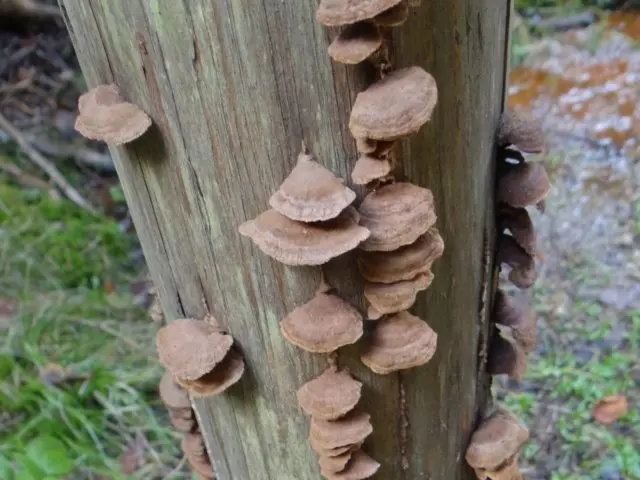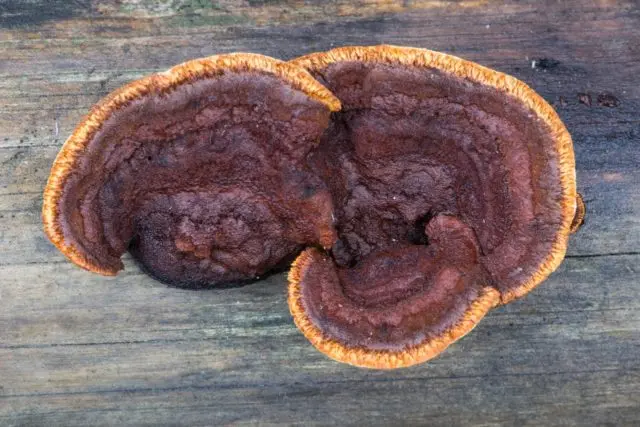Contents
Gleophyllum fir is a tree species that grows everywhere, but is rare. It is one of the members of the Gleophyllic family. This mushroom is perennial, so you can find it in its natural environment all year round. In official sources, it is listed as Gloeophyllum abietinum.
What does gleophillum fir look like?
The fruiting body of Gleophyllum fir consists of a cap. It has a semicircular or fan-like shape. The fungus grows singly or in small groups, but as a result of many years of growth, individual specimens grow together and form a single prostrate sessile hat.
Gleophyllum fir is attached to the substrate with a wide side. Its size is small, it reaches 2-8 cm in length, and 0,3-1 cm in width at the base. The edge of the cap is thin, sharp. The color of the fruiting body varies depending on the stage of development. In young specimens, it is amber-beige or brown, and then becomes brown-black. The edge of the cap is initially lighter than the main tone, but eventually merges with the rest of the surface.
The upper side of the fruit body in young fir gleophyllums is velvety to the touch. But as it grows, the surface becomes bare and small grooves appear on it.
At the break, you can see the fibrous pulp of a reddish-brown hue. Its thickness is 0,1-0,3 mm. Closer to the surface of the cap, it is loose, and near the edge it is dense.
On the reverse side of the fruiting body there are rare wavy plates with bridges. Initially, they have a whitish tint, and over time they become brown with a specific coating. The spores of Gleophyllum fir are elliptical or cylindrical. Their surface is smooth. Initially, they are colorless, but when ripe, they acquire a light brown hue. Their size is 9-13*3-4 microns.

Gleophyllum fir contributes to the development of brown rot
Where and how to grow
This species grows in the subtropics and temperate zone. The fungus prefers to settle on dead wood and half-decayed stumps of conifers: firs, spruces, pines, cypresses and junipers. Sometimes gleophillum fir is found on hardwoods, in particular on birch, oak, poplar, beech.
In Our Country, the fungus is distributed throughout the territory, but is more common in the European part, Siberia and the Far East.
Gleophyllum fir also grows:
- in Europe;
- in Asia;
- in the Caucasus;
- in North Africa;
- in New Zealand;
- in North America.
Is the mushroom edible or not?
This species is considered inedible. It is strictly forbidden to eat it in fresh and processed form.
Twins and their differences
By external signs, this species can be confused with its other close relative – the fence gleophyllum, but the latter has a lighter color. Its other names are:
- Agaricus sepiarius;
- Merulius sepiarius;
- Lenzites sepiarius.
The shape of the fruiting body of the twin is reniform or semicircular. The size of the cap reaches a length of 12 cm, and a width of 8 cm. The mushroom belongs to the category of inedible.
The surface of young specimens is velvety, and then becomes coarsely hairy. Concentric texture zones are clearly visible on it. The color from the edge has a yellow-orange tint, and then turns into a brown tone and becomes black towards the center.
The period of active growth of Gleophyllum Fence lasts from summer to late autumn, but in countries with a temperate climate, the fungus grows year-round. This species lives on stumps, dead wood and deadwood of coniferous trees, less often deciduous ones. Widely distributed in the Northern Hemisphere. The official species name is Gloeophyllum sepiarium.

Gleophyllum fence is considered an annual tree fungus, but there are also cases of two-year growth of the fruiting body.
Conclusion
Gleophyllum fir, due to its inedibility, is not of interest to lovers of quiet hunting. But mycologists are actively studying its properties. Therefore, research in this area is still ongoing.









